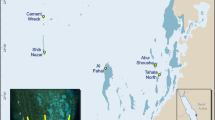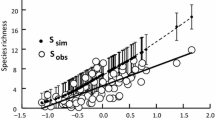Abstract
The widespread decline of coral reefs requires integrated management measures across whole regions. Knowledge of demographic processes of reef organisms is important for informed management, yet current techniques for assessing such processes are time consuming, making it impractical to gather relevant information over large scales. We tested the usefulness of digital still photography as a rapid assessment technique to estimate coral recruitment—an important process in coral reef recovery. Estimates of the density and diversity of juvenile hard corals from digital images were compared with direct visual estimates from the same plots made in the field. Multiple plots were sampled on four reefs from a range of locations on Australia’s Great Barrier Reef. On average, estimates of juvenile densities from photographic images were lower, in both absolute and relative terms, than that estimated from images. This was the case whether colonies <20 mm or <50 mm in diameter were considered. Overall differences between methods were generally greater at reefs where recruitment was higher, though proportional differences (density from images/density from direct visual census) still varied among reefs. Although the ranking of taxa, in terms of their densities, from the two methods were similar, the density of common genera was generally underestimated in images, and the occurrence of ‘unknown’ taxa was higher. We conclude that photographic images do not constitute a reliable rapid assessment method for estimating the spatial patterns in the density or diversity of juvenile hard corals.
Similar content being viewed by others
References
Abdo, D., Burgess, S., Coleman, G., & Osborne, K. (2003). Surveys of benthic communities using underwater video. Long-term Monitoring of the Great Barrier Reef Standard Operating Procedure No. 2 (3rd revised ed.). Townsville: Australian Institute of Marine Science.
Bak, R. P. M., & Engel, M. S. (1979). Distribution, abundance, and survival of juvenile hermatypic corals (Scleractinia) and the importance of life history strategies in the parent community. Marine Biology, 54, 341–352.
Bolker, B. M., Brooks, M. E., Clark, C. J., Geange, S. W., Poulsen, J. R., Stevens, M. H. H., et al. (2008). Generalized linear mixed models: A practical guide for ecology and evolution. Trends in Ecology and Evolution, 24, 127–135.
Caley, M. J., Carr, M. H., Hixon, M. A., Hughes, T. P., Jones, G. P., & Menge, B. A. (1996). Recruitment and the local dynamics of open marine populations. Annual Review of Ecology and Systematics, 27, 477–500.
Chiappone, M., & Sullivan, K. M. (1996). Distribution, abundance, and species composition of juvenile scleractinian corals in the Florida reef tract. Bulletin of Marine Science, 58, 555–569.
Connell, J. H., Hughes, T. P., & Wallace, C. C. (1997). A 30-year study of coral abundance, recruitment, and disturbance at several scales in space and time. Ecological Monographs, 67, 461–488.
Done, T. (1981). Photogrammetry in coral ecology: A technique for the study of change in coral communities. Proceedings of the 4th International Coral Reef Symposium, 2, 315–320.
Edmunds, P. J. (2000). Patterns in the distribution of juvenile corals and coral reef community structure in St John, US Virgin Islands. Marine Ecology Progress Series, 202, 113–124.
Edmunds, P. J., Aronson, P. J., Swanson, D. W., Levitan, D. R., & Precht, W. F. (1998). Photographic versus visual census techniques for the quantification of juvenile corals. Bulletin of Marine Science, 62, 937–946.
Glassom, D., & Chadwick, N. E. (2006). Recruitment, growth, and mortality of juvenile corals at Eilat, Northern Red Sea. Marine Ecology Progress Series, 318, 111–122.
Harrison, P. L., & Wallace, C. C. (1990). Reproduction, dispersal, and recruitment of scleractinian corals. In Z. Dubinsky (Ed.), Ecosystems of the world, coral reefs (Vol. 25, pp. 130–207). New York: Elsevier.
Hughes, T. P., & Tanner, J. E. (2000). Recruitment failure, life histories, and long-term decline of Caribbean corals. Ecology, 81, 2250–2263.
Lirman, D., Gracias, N. R., Gintert, B. E., Gleason, A. C. R., Reid, R. P., Negahdaripour, S., et al. (2007). Development and application of a video-mosaic survey technology to document the status of coral communities. Environmental, Monitoring, and Assessment, 125, 59–73
Miller, M. W., Weil, E., & Szmant, A. M. (2000). Coral recruitment and juvenile mortality as structuring factors for reef benthic communities in Biscayne National Park, USA. Coral Reefs, 19, 115–123.
Nyström, M., Folke, C., & Moberg, F. (2000). Coral reef disturbance and resilience in a human-dominated environment. Trends in Ecology and Evolution, 15(10), 413–417.
Pearson, R. G. (1981). Recovery and recolonisation of coral reefs. Marine Ecology Progress Series, 4, 105–122.
Pinheiro, J. C., & Bates, D. M. (2000). Mixed-effects models in S and S-plus. Berlin: Springer.
R Development Core Team (2006). R: A language and environment for statistical computing. R Foundation for Statistical Computing, Vienna, Austria. ISBN 3-900051-07-0. Retrieved from http://www.R-project.org.
Ruiz-Zárate, M. A., & Arias-González, J. E. (2004). Spatial study of juvenile corals in the Northern region of the Mesoamerican Barrier Reef System (MBRS). Coral Reefs, 23, 584–594.
Sweatman, H. P. A., Cheal, A. J., Coleman, G. J., Emslie, M. J., Johns, K., Jonker, M., et al. (2008). Long-term monitoring of the Great Barrier Reef. Status Report Number 8. Townsville: Australian Institute of Marine Science.
Venables, W. N., & Ripley, B. D. (2002). Modern applied statistics with S (4th ed., p. 495). Berlin: Springer.
Wells, S. M. (1995). Science and management of coral reefs: Problems and prospects. Corals Reefs, 14, 177–181.
Wilkinson, C. R. (Ed.) (2004). Status of coral reefs of the world: 2004. Townsville: Australian Institute of Marine Science.
Author information
Authors and Affiliations
Corresponding author
Rights and permissions
About this article
Cite this article
Burgess, S.C., Osborne, K., Sfiligoj, B. et al. Can juvenile corals be surveyed effectively using digital photography?: implications for rapid assessment techniques. Environ Monit Assess 171, 345–351 (2010). https://doi.org/10.1007/s10661-009-1282-1
Received:
Accepted:
Published:
Issue Date:
DOI: https://doi.org/10.1007/s10661-009-1282-1




